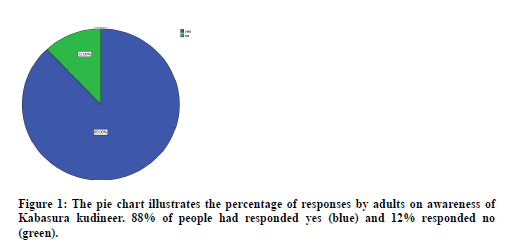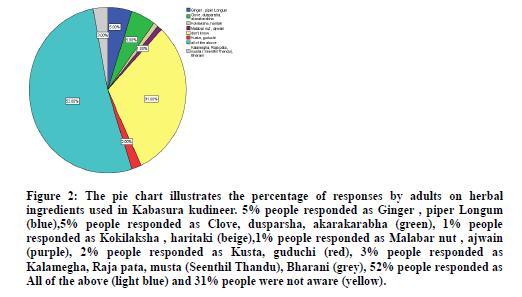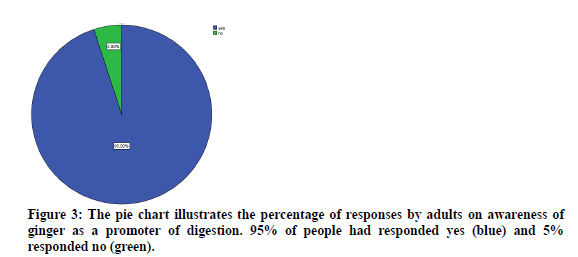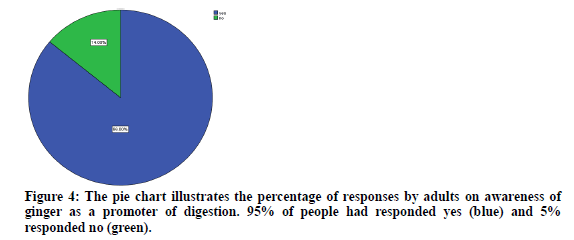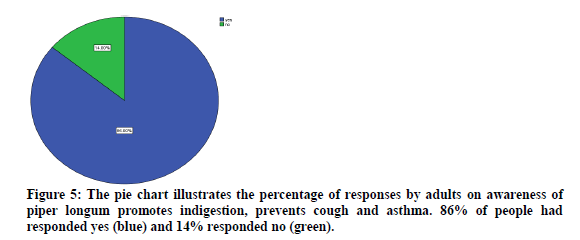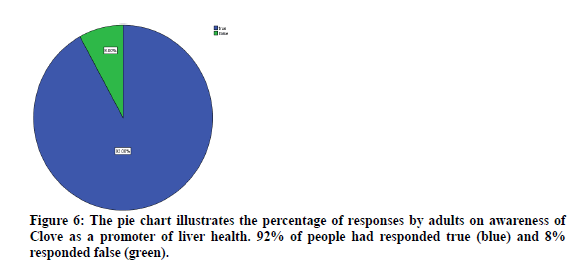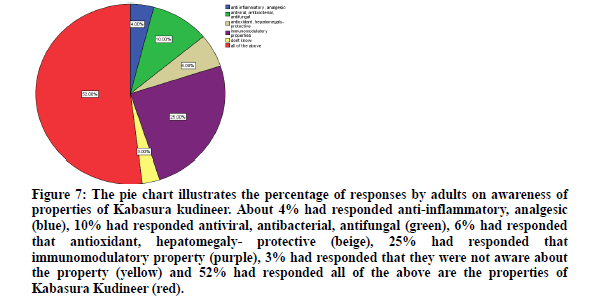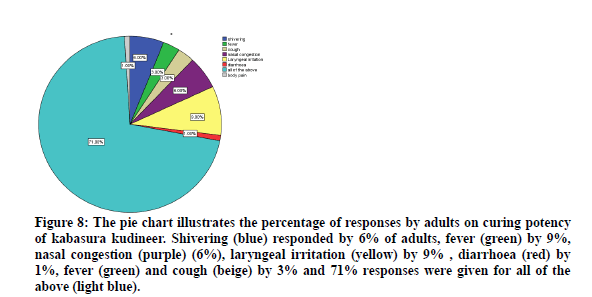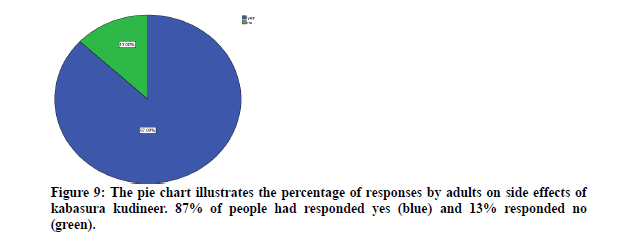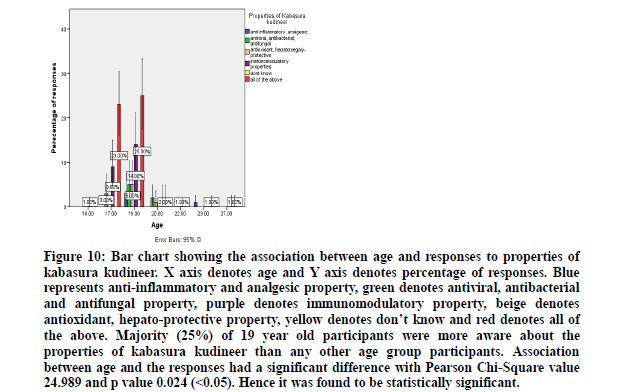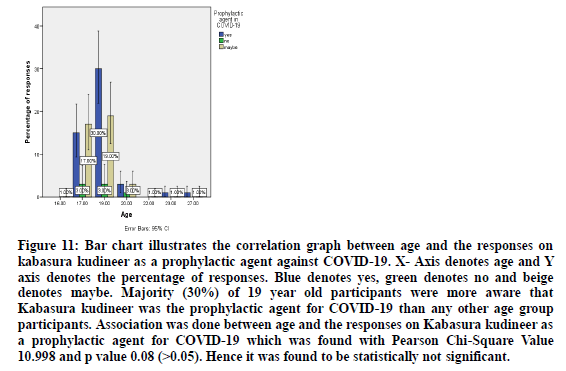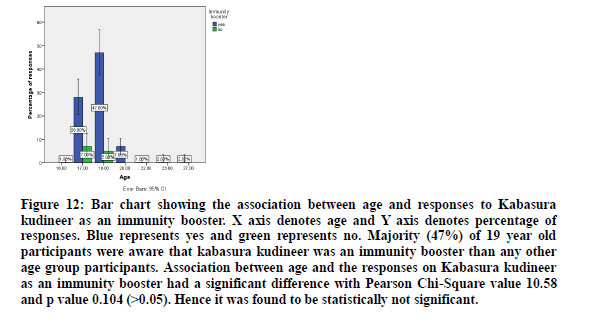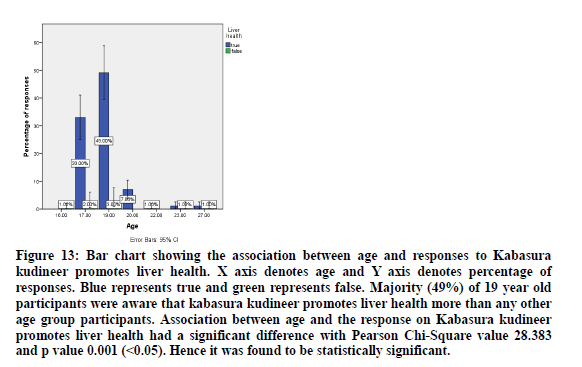Research - (2021) Volume 9, Issue 11
Awareness on Role of Kabasura Kudineer on Immunity among Adult Population
Tahoora Taskeen L, V Vishnu Priya* and R. Gayathri
*Correspondence: V Vishnu Priya, Department of Biochemistry, Saveetha Institute of Medical and Technical Sciences, Saveetha University, Chennai-600077, India, Email:
Abstract
Introduction: Kabasura kudineer is a concoction prepared as a siddha product which is effective against respiratory infection. It is made with the use of 15 herbs which includes ginger, clove, Piper Longum, Dusparsha, Akarakarabha, Kokilaksha, heritage, Malabar nut, ajwain, Kusta, guduchi, Kalamegha, Raja pata, musta and Bharani. Each and every ingredient has its own importance like ginger promotes digestion and helps in treatment of respiratory ailments, Pippalli can treat indigestion, asthma and cough, clove helps to kill bacteria and promote liver health etc. Thus the aim of the study is to analyse the knowledge and awareness on the role of Kabasura kudineer on immunity among the adult population. Materials and methods: Self-administered structured questionnaires were designed based on the knowledge and awareness of the role of Kabasura kudineer on immunity among adults. The questionnaire was distributed through online goggle forms link; the study population included 100 dental students in Chennai. The data was collected and statistically analysed in SPSS of version 26.0.The study was approved by the Institutional Review Board. Results: Majority of 19 year old (52%) individuals had responded whereas 35% of 17 year old respondents among them nearly 97% were females and 88% were aware of kabasura kudineer. It was appreciable that 83% of respondents were aware that kabasura kudineer was a siddha formulation and only 50% were aware it was administered as concoction among which 78% of individuals knew that it is a perfect remedy for respiratory ailments. Majority (52%) respondents were aware about the herbal ingredients used. Conclusion: Thus majority of adults were not aware about the properties of Kabasura kudineer. More awareness programmes have to be done to make Kabasura kudineer a prophylactic agent world-wide.
Keywords
Novel method, Kabasura kudineer, COVID-19, Chooranam, Immunity, Management; Eco-friendly; Innovative technique
Introduction
COVID-19 is viral disease which was pandemic worldwide in 2020 and many of the developed countries and underdeveloped countries lost mass of population. As it was an airborne infection it was difficult to control but in South India Kabasura kudineer chooranam was supplied as a remedy of control programme [1-5].
Kabasura kudineer is a concoction prepared as a siddha product which is effective against respiratory infection [1]. It is made with the use of 15 herbs which includes ginger, clove, Piper Longum, Dusparsha, Akarakarabha, Kokilaksha, haritaki, Malabar nut, ajwain, Kusta, guduchi, Kalamegha, Raja pata, musta and Bharani [2]. Each and every ingredient has its own importance like ginger promotes digestion and helps in treatment of respiratory ailments [3]. Pippalli can treat indigestion, asthma and cough, clove helps to kill bacteria and promote liver health, Dusparsha is used to treat haemorrhoids, kusta treats gout and indigestion, raja pata and musta relieves from fever, guduchi has antipyretic and immunomodulatory effect [4-6].
Kabasura kudineer has anti-inflammatory, analgesic, antiviral, antifungal, antioxidant, hepato-protective, antipyretic, anti-asthmatic and immunomodulatory properties [7]. The properties of kabasura kudineer is a preferable treatment for fever, shivering, cough, congestion of nose, laryngeal irritation, diarrhoea etc. 25-50 ml of Kabasura kudineer given for 6-12 weeks to boost the immunity [8,9]. Hence due to its potent immunological properties it is suggested by Tamil Nadu government as a remedy for COVID-19 control but most of the population are unaware of its importance and properties.
According previous researches Rjalakshmi K et al in 2018 had tested the antimicrobial efficacy of kabasura kudineer and reported that it had potent action against bacteria’s and viruses similar to commercial medicines [10] whereas Natarajan S et al in 2020 had done a randomized control trial with kabasura kudineer and vitamin C supplementation for asymptomatic COVID-19 and they found a positive outcome with the users of kabasura kudineer chooranam [5]. A survey study is been reported by Dharani Bala et al in 2020 in Tamil nadu and found that there is a need to improve the attitude of people towards the use of Kabasura kudineer to boost their immunity and in rural areas people use kabasura kudineer as a home remedy to resist Covid-19 [11].
Henceforth it is the need of the hour to detect the awareness and knowledge of people over use of Kabasura kudineer which can be a side effect free booster of immunity and prevent people from various ailments especially respiratory infections. Our team has extensive knowledge and research experience that has translate into high quality publications [12-31]. Thus the aim of the study is to analyse the knowledge and awareness on the role of Kabasura kudineer on immunity among the adult population.
Material and Method
Self-administered structured questionnaires were designed based on the knowledge and awareness on the role of Kabasura kudineer on immunity among the adult population. . The questionnaire was distributed through online goggle forms link; the study population included 100 adults in Chennai. The participants were explained about the purpose of the study in detail. The questions were carefully studied and the corresponding answers were marked by the participants. The data was collected and statistically analysed in SPSS Version 23.0.The study was approved by the Institutional Review Board.
Results
Majority of 19 year old (52%) individuals had responded whereas 35% of 17 year old respondents among them nearly 97% were females and 88% were aware of kabasura kudineer. It was appreciable that 83% of respondents were aware that kabasura kudineer was a siddha formulation and only 50% were aware it was administered as concoction among which 78% of individuals knew that it is a perfect remedy for respiratory ailments. Majority (52%) respondents were aware about the herbal ingredients used. 95% of respondents knew that ginger promotes digestion. 86% respondents were aware that piper longum treats indigestion, asthma and cough whereas 92% were aware that clove helps in killing bacteria and promotes liver health. 59% of respondents had reported that dushpredha helps to treat haemorrhoids and 82% had declared that Kusta treats gout and indigestion. 63 % of respondents were aware that Raja pata and musta relieves them from fever.
Nearly 52% of respondents knew that antipyretic and immunomodulatory property and the properties of kabasura kudineer and the association between age and the responses had a significant difference with Chi- Square value 24.989 and p value 0.024 (<0.05) . Hence it was found to be statistically significant. 71% of respondents reported that kabasura kudineer provides effective remedy for fever, shivering, cough, nasal congestion, laryngeal irritation, diarrhoea, body pain whereas only 16% were aware that it will be given for 24 days and 9% were aware that it will be given 100-120ml. 59% respondent reported that kabasura kudineer has no side effect whereas 87% respondents reported that it boosts immunity and 49% reported that it helped in managing COVID-19 and used as prophylactic against COVID-19 which 86% were aware that Tamil Nadu government helped to supply kabasura kudineer which helped the government to control COVID. Association between age and the responses on Kabasura kudineer as an immunity booster had a significant difference with Pearson Chi-Square value 10.58 and p value 0.104 (>0.05). Hence it was found to be statistically not significant. Association between age and the response on Kabasura kudineer promotes liver health had a significant difference with Pearson Chi-Square value 28.383 and p value 0.001 (<0.05). Hence it was found to be statistically significant (Figures 1-13).
Figure 1:The pie chart illustrates the percentage of responses by adults on awareness of Kabasura kudineer. 88% of people had responded yes (blue) and 12% responded no (green).
Figure 2:The pie chart illustrates the percentage of responses by adults on herbal ingredients used in Kabasura kudineer. 5% people responded as Ginger , piper Longum (blue),5% people responded as Clove, dusparsha, akarakarabha (green), 1% people responded as Kokilaksha , haritaki (beige),1% people responded as Malabar nut , ajwain (purple), 2% people responded as Kusta, guduchi (red), 3% people responded as Kalamegha, Raja pata, musta (Seenthil Thandu), Bharani (grey), 52% people responded as All of the above (light blue) and 31% people were not aware (yellow).
Figure 3:The pie chart illustrates the percentage of responses by adults on awareness of ginger as a promoter of digestion. 95% of people had responded yes (blue) and 5% responded no (green).
Figure 4:The pie chart illustrates the percentage of responses by adults on awareness of ginger as a promoter of digestion. 95% of people had responded yes (blue) and 5% responded no (green).
Figure 5:The pie chart illustrates the percentage of responses by adults on awareness of piper longum promotes indigestion, prevents cough and asthma. 86% of people had responded yes (blue) and 14% responded no (green).
Figure 6:The pie chart illustrates the percentage of responses by adults on awareness of Clove as a promoter of liver health. 92% of people had responded true (blue) and 8% responded false (green).
Figure 7:The pie chart illustrates the percentage of responses by adults on awareness of properties of Kabasura kudineer. About 4% had responded antiinflammatory, analgesic (blue), 10% had responded antiviral, antibacterial, antifungal (green), 6% had responded that antioxidant, hepatomegalyprotective (beige), 25% had responded that immunomodulatory property (purple), 3% had responded that they were not aware about the property (yellow) and 52% had responded all of the above are the properties of Kabasura Kudineer (red).
Figure 8:The pie chart illustrates the percentage of responses by adults on curing potency of kabasura kudineer. Shivering (blue) responded by 6% of adults, fever (green) by 9%, nasal congestion (purple) (6%), laryngeal irritation (yellow) by 9% , diarrhoea (red) by 1%, fever (green) and cough (beige) by 3% and 71% responses were given for all of the above (light blue).
Figure 9:The pie chart illustrates the percentage of responses by adults on side effects of kabasura kudineer. 87% of people had responded yes (blue) and 13% responded no (green).
Figure 10: Bar chart showing the association between age and responses to properties of kabasura kudineer. X axis denotes age and Y axis denotes percentage of responses. Blue represents antiinflammatory and analgesic property, green denotes antiviral, antibacterial and antifungal property, purple denotes immunomodulatory property, beige denotes antioxidant, hepato-protective property, yellow denotes don’t know and red denotes all of the above. Majority (25%) of 19 year old participants were more aware about the properties of kabasura kudineer than any other age group participants. Association between age and the responses had a significant difference with Pearson Chi-Square value 24.989 and p value 0.024 (<0.05). Hence it was found to be statistically significant.
Figure 11: Bar chart illustrates the correlation graph between age and the responses on kabasura kudineer as a prophylactic agent against COVID-19. XAxis denotes age and Y axis denotes the percentage of responses. Blue denotes yes, green denotes no and beige denotes maybe. Majority (30%) of 19 year old participants were more aware that Kabasura kudineer was the prophylactic agent for COVID-19 than any other age group participants. Association was done between age and the responses on Kabasura kudineer as a prophylactic agent for COVID-19 which was found with Pearson Chi-Square Value 10.998 and p value 0.08 (>0.05). Hence it was found to be statistically not significant.
Figure 12: Bar chart showing the association between age and responses to Kabasura kudineer as an immunity booster. X axis denotes age and Y axis denotes percentage of responses. Blue represents yes and green represents no. Majority (47%) of 19 year old participants were aware that kabasura kudineer was an immunity booster than any other age group participants. Association between age and the responses on Kabasura kudineer as an immunity booster had a significant difference with Pearson Chi- Square value 10.58 and p value 0.104 (>0.05). Hence it was found to be statistically not significant.
Figure 13: Bar chart showing the association between age and responses to Kabasura kudineer promotes liver health. X axis denotes age and Y axis denotes percentage of responses. Blue represents true and green represents false. Majority (49%) of 19 year old participants were aware that kabasura kudineer promotes liver health more than any other age group participants. Association between age and the response on Kabasura kudineer promotes liver health had a significant difference with Pearson Chi- Square value 28.383 and p value 0.001 (<0.05). Hence it was found to be statistically significant.
Discussion
Our team has extensive knowledge and research experience that has translate into high quality publications [12-31]. Based on the previous study done by S.Natarajan in 2020, the author had reported that Kabasura kudineer was more potent in controlling and treating COVID-19 over Vitamin C Supplementation whereas from our study nearly 50% were aware that it helped as a prophylactic agent in controlling COVID -19 but on comparison between the management of COVID -19 with Kabasura kudineer with age illustrated no significant difference (p= 0.09).
Similarly, in the other study done by Sree kumar 2020 [32] reported that kabasura kudineer helps to bring body to normal conditions in respiratory illness whereas in the current study 78% respondents were aware that kabasura kudineer helps in curing respiratory ailments. The correlation between the responses on kabasura kudineer treating respiratory ailments with age demonstrated significant difference with p value 0.01.
A previous study done on Coronavirus spike glycoproteins targeted siddha medicine (kabasura kudineer) and concluded that the phytocompounds prevents the binding of spikes with host receptors and acts as potential prophylactic agents in managing COVID-19 whereas in the current study 82% were aware that COVID -19 is been controlled by the government with the use of Kabasura kudineer. The comparison between Control of COVID-19 by the government with age showed no significant difference with p value 0.18 [33-35].
There are several limitations of the study such as increase in sample size, inclusion of more criteria, survey fatigue, homogenous population and response bias. Future scope of the study is that awareness about the concoction can help people to use it on a daily basis to keep them protected against infections like COVID-19 and scientific approach in medicine can be done to avoid complications which would help them to be safe from Coronavirus.
Conclusion
Within the limitations of the study, the current study concludes that sufficient knowledge was not found among adults about kabasura kudineer and its uses in preventing COVID-19. Hence more studies have to be done to make it as a prophylactic agent which could be used worldwide with fewer side effects.
Author Contribution
Tahoora Taskeen L and Vishnu Priya had done the questionnaire preparation, data collection, statistical analysis and manuscript writing. Vishnu Priya had edited and revised the manuscript of the present study.
Funding Source
The present study was supported by the following agencies.
Saveetha Dental College, SIMATS, Saveetha University.
Tancreative company.
Acknowledgement
The authors are grateful to the participants of the study for helping us to complete the study with perfect results.
Conflict of Interest
The author declares that there was no conflict of interest in the present study.
References
- https://web.archive.org/web/20200905051558id_/https://www.protocols.io/view/a-prospective-single-centre-randomized-open-labell-biebkban.pdf
- Anbarasu K, Manisenthil KK, Ramachandran S. Antipyretic, anti-inflammatory and analgesic properties of nilavembu kudineer choornam: a classical preparation used in the treatment of chikungunya fever. Asian Pac J Trop Med 2011; 4:819-23.
- Wang Z, Ji JS, Liu Y, et al. Survival analysis of hospital length of stay of novel coronavirus (COVID-19) pneumonia patients in Sichuan, China. Med Rxiv 2020.
- Gopalasatheeskumar K, Karthikeyen L, Anguraj M, et al. Screening of kabasura kudineer chooranam against COVID-19 through targeting of main protease and RNA-dependent RNA polymerase of SARS-Cov-2 by molecular docking studies. SSRN: Rochester, NY, USA 2020.
- Natarajan S, Anbarasi C, Sathiyarajeswaran P, et al. The efficacy of siddha medicine, kabasura kudineer (KSK) compared to Vitamin C & Zinc (CZ) supplementation in the management of asymptomatic COVID-19 cases: A structured summary of a study protocol for a randomised controlled trial. Trials 2020; 21:1-2.
- https://papers.ssrn.com/sol3/papers.cfm?abstract_id=3659092
- Maniyan KA, Sindhu A. PA02. 18. Phytochemical screening and antioxidant activity of Amrutha Choornam. Anc Sci Life 2013; 32:S63.
- Gopalasatheeskumar K, Lakshmanan K, Moulishankar A, et al. Screening of kabasura kudineer chooranam against COVID-19 through targeting of main protease and RNA-dependent RNA polymerase of SARS-CoV-2 by molecular docking studies. Asian J Org Med Chem 2021; 5:319–31.
- Kiran G, Karthik L, Devi MS, et al. In silico computational screening of Kabasura Kudineer-official Siddha formulation and JACOM against SARS-CoV-2 spike protein. J Ayurveda Integr Med 2020.
- Rajalakshmi K, Shanmugapriya P, Christian G, et al. Antimicrobial potential of siddha polyherbal formulation aavarai kudineer. J Pure Appl Microbio 2018; 12:1019-25.
- Bala D. Attitudes, beliefs, and self-use of kabasura kudineer among urban and rural population in Tamil Nadu, India: A comparative cross-sectional study. J Fam Med Prim Care 2021; 10:158.
- Wu F, Zhu J, Li G, et al. Biologically synthesized green gold nanoparticles from Siberian ginseng induce growth-inhibitory effect on melanoma cells (B16). Artif Cells Nanomed Biotechnol 2019; 47:3297-305.
- Chen F, Tang Y, Sun Y, et al. 6-shogaol, a active constiuents of ginger prevents UVB radiation mediated inflammation and oxidative stress through modulating NrF2 signaling in human epidermal keratinocytes (HaCaT cells). J Photochem Photobiol 2019; 197:111518.
- Li Z, Veeraraghavan VP, Mohan SK, et al. Apoptotic induction and anti-metastatic activity of eugenol encapsulated chitosan nanopolymer on rat glioma C6 cells via alleviating the MMP signaling pathway. J Photochem Photobiol 2020; 203:111773.
- Babu S, Jayaraman S. An update on ß-sitosterol: A potential herbal nutraceutical for diabetic management. Biomed. Pharmacother 2020; 131:110702.
- Malaikolundhan H, Mookkan G, Krishnamoorthi G, et al. Anticarcinogenic effect of gold nanoparticles synthesized from Albizia lebbeck on HCT-116 colon cancer cell lines. Artif Cells Nanomed Biotechnol 2020; 48:1206-1213.
- Han X, Jiang X, Guo L, et al. Anticarcinogenic potential of gold nanoparticles synthesized from Trichosanthes kirilowii in colon cancer cells through the induction of apoptotic pathway. Artif Cells Nanomed Biotechnol 2019; 47:3577-3584.
- Gothai S, Muniandy K, Gnanaraj C, et al. Pharmacological insights into antioxidants against colorectal cancer: A detailed review of the possible mechanisms. Biomed Pharmacother 2018; 107:1514-1522.
- Veeraraghavan VP, Hussain S, Papayya Balakrishna J, et al. A comprehensive and critical review on ethnopharmacological importance of desert truffles: Terfezia claveryi, Terfezia boudieri, and Tirmania nivea. Food Rev Int 2021; 1-20.
- Sathya S, Ragul V, Veeraraghavan VP, et al. An in vitro study on hexavalent chromium [Cr (VI)] remediation using iron oxide nanoparticles based beads. Environ Nanotechnol Monit Manag 2020; 14:100333.
- Yang Z, Pu M, Dong X, et al. Piperine loaded zinc oxide nanocomposite inhibits the PI3K/AKT/mTOR signaling pathway via attenuating the development of gastric carcinoma: In vitro and in vivo studies. Arab J Chem 2020; 13:5501-16.
- Rajendran P, Alzahrani AM, Rengarajan T, et al. Consumption of reused vegetable oil intensifies BRCA1 mutations. Crit Rev Food Sci Nutr 2021; 1-8.
- Barma MD, Muthupandiyan I, Samuel SR, et al. Inhibition of Streptococcus mutans, antioxidant property and cytotoxicity of novel nano-zinc oxide varnish. Arch Oral Biol 2021; 126:105132.
- Samuel SR. Can 5-year-olds sensibly self-report the impact of developmental enamel defects on their quality of life?. Int J Paediatr Dent 2021; 31:285-286.
- Samuel SR, Kuduruthullah S, Khair AM, et al. Dental pain, parental SARS-CoV-2 fear and distress on quality of life of 2 to 6 year-old children during COVID-19. Int J Paediatr Dent 2021; 31:436-41.
- Bigham A, Salehi AO, Rafienia M, et al. Zn-substituted Mg2SiO4 nanoparticles-incorporated PCL-silk fibroin composite scaffold: A multifunctional platform towards bone tissue regeneration. Mater Sci Eng C 2021; 112242.
- Yin Z, Yang Y, Guo T, et al. Potential chemotherapeutic effect of betalain against human non-small cell lung cancer through PI3K/Akt/mTOR signaling pathway. Environ Toxicol 2021; 36:1011-1020.
- Veeraraghavan VP, Periadurai ND, Karunakaran T, et al. Green synthesis of silver nanoparticles from aqueous extract of Scutellaria barbata and coating on the cotton fabric for antimicrobial applications and wound healing activity in fibroblast cells (L929). Saudi J Biol Sci 2021.
- Mickymaray S, Alfaiz FA, Paramasivam A, et al. Rhaponticin suppresses osteosarcoma through the inhibition of PI3K-Akt-mTOR pathway. Saudi J Biol Sci 2021.
- Teja KV, Ramesh S. Is a filled lateral canal–A sign of superiority?. J Dent Sci 2020; 15:562.
- Kadanakuppe S, Hiremath S. Social and behavioural factors associated with dental caries experience among adolescent school children in Bengaluru City, India. Br J Med Med Res 2016; 14: 1–10.
- Sreekumar K, Abraham A. Phytochemical, antimicrobial and antioxidant evaluation of Gulgulupanchapala choornam. InAIP Conference Proceedings 2020; 2263:030002.
- Shahzad A, Sahai A. In Vitro conservation protocols for some endangered medicinal-plant. In Recent Trends in Biotechnology and Therapeutic Applications of Medicinal Plants 2013; 305-321.
- Rajalakshmi S, Samraj K, Sathiyarajeswaran P, et al. Preparedness of siddha system of medicine in practitioner perspective during a pandemic outbreak with special reference to COVID-19. Cell Med 2020; 10:29-1.
- Ramalingam V, Venkataramani G. Unlocking the potential of traditional native medicines-A perspective to manage the COVID-19 pandemic. J Res Tradit Med 2020; 6:21-28.
Author Info
Tahoora Taskeen L, V Vishnu Priya* and R. Gayathri
Department of Biochemistry, Saveetha Institute of Medical and Technical Sciences, Saveetha University, Chennai-600077, IndiaCitation: Tahoora Taskeen L, V Vishnu Priya, R Gayathri, Awareness on Role of Kabasura Kudineer on Immunity among Adult Population , J Res Med Dent Sci, 2021, 9(11): 235-241
Received: 09-Sep-2021 Accepted: 10-Nov-2021

